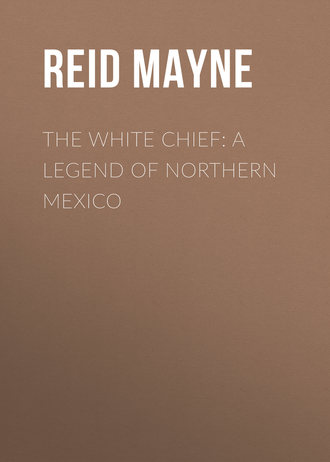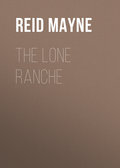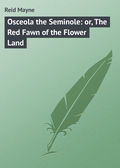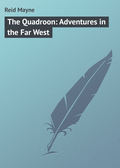
Майн Рид
The White Chief: A Legend of Northern Mexico
Chapter Nine
Though the field-sports were over, the fiesta of San Juan was not yet ended. There were still many sights to be seen before the crowd scattered to their homes. There was to be another turn at the church – another sale of “indultos,” beads, and relics, – another sprinkling of sacred water, in order that the coffers of the padrés might be replenished toward a fresh bout at the monté table. Then there was an evening procession of the Saint of the day (John), whose image, set upon a platform, was carried about the town, until the five or six fellows who bore the load were seen to perspire freely under its weight.
The Saint himself was a curiosity. A large wax and plaster doll, dressed in faded silk that had once been yellow, and stuck all over with feathers and tinsel. A Catholic image Indianised, for the Mexican divinities were as much Indian as Roman. He appeared bored of the business, as, the joinings between head and neck having partially given way, the former drooped over and nodded to the crowd as the image was moved along. This nodding, however, which would have been laughed at as supremely ridiculous in any other than a priest-ridden country, was here regarded in a different light. The padrés did not fail to put their interpretation upon it, pointing it out to their devout followers as a mark of condescension on the part of the Saint, who, in thus bowing to the crowd, was expressing his approbation of their proceedings. It was, in fact, a regular miracle. So alleged both padrés and cura, and who was there to contradict them? It would have been a dangerous matter to have said nay. In San Ildefonso no man dared to disbelieve the word of the Church. The miracle worked well. The religious enthusiasm boiled up; and when Saint John was returned to his niche, and the little “cofre” placed in front of him, many a “peseta,” “real,” and “cuartillo,” were dropped in, which would otherwise have been deposited that night in the monté bank. Nodding Saints and “winking Madonnas” are by no means a novel contrivance of the Holy Church. The padrés of its Mexican branch have had their wonderful saints too; and even in the almost terra ignota of New Mexico can be found a few of them that have performed as smart miracles as any recorded in the whole jugglery of the race.
A pyrotechnic display followed – and no mean exhibition of the sort neither – for in this “art” the New Mexicans are adepts. A fondness for “fireworks” is a singular but sure characteristic of a declining nation.
Give me the statistics of pyrotechnic powder burnt by a people, and I shall tell you the standard measure of their souls and bodies. If the figure be a maximum, then the physical and moral measure will be the minimum, for the ratio is inverse.
I stood in the Place de Concorde, and saw a whole nation – its rich and its poor – gazing on one of these pitiful spectacles, got up for the purpose of duping them into contentment. It was the price paid them for parting with their liberty, as a child parts with a valuable gem for a few sugar-plums. They were gazing with a delight that seemed enthusiasm! I looked upon scrubby, stunted forms, a foot shorter than were their ancestors. I looked upon eyes that gleamed with demoralised thought.
These were the representatives of a once great people, and who still deem themselves the first of mankind. I felt sure that this was an illusion. The pyro-spectacle and its reception convinced me that I saw before me a people who had passed the culminating point of their greatness, and were now gliding rapidly down the declining slope that leads to annihilation and nothingness.
After the fireworks came the “fandango.” There we meet the same faces, without much alteration in the costumes. The señoras and señoritas alone have doffed their morning dresses, and here and there a pretty poblana has changed her coarse woollen “nagua” for a gay flounced muslin.
The ball was held in the large saloon of the “Casa de Cabildo,” which occupied one side of the “Plaza.” On this festival day there was no exclusiveness. In the frontier towns of Mexico not much at any time, for, notwithstanding the distinctions of class, and the domineering tyranny of the government authorities, in matters of mere amusement there is a sort of democratic equality, a mingling of high and low, that in other countries is rare. English, and even American travellers, have observed this with astonishment.
All were admitted to the “Salon de baile” who chose to pay for it; and alongside the rico in fine broad-cloth you might see the ranchero in his leathern jacket and velveteen calzoneros; while the daughter of the rich comerciante danced in the same set with the “aldeana,” whose time was taken up in kneading tortillas or weaving rebosos!
The Comandante with Roblado and the lieutenant figured at the fandango in full uniform. The alcalde was there with his gold-headed cane and tassel; the cura in his shovel hat; the padrés in their swinging robes; and all the “familias principales” of the place.
There was the rich comerciante, Don José Rincon, with his fat wife and four fat sleepy-looking daughters – there, too, the wife and family of the alcalde – there the Echevarrias, with their brother the “beau” in full Paris costume, with dress coat and crush hat – the only one to be seen in the saloon. There, too, the rich hacendado, Señor Gomez del Monté, with his lean wife and several rather lean daughters – differing in that respect from the hundreds of kine that roam over the pastures of his “ganada.” And there, too, observed of all, was the lovely Catalina de Graces, the daughter of the wealthy miner Don Ambrosio, who himself is by her side, keeping a watchful eye upon her.
Besides these grand people there were employés of the mines of less note, clerks of the comerciantes, young farmers of the valley, gambucinos, vaqueros, ciboleros, and even “leperos” of the town, shrouded in their cheap serapés. A motley throng was the fandango.
The music consisted of a bandolon, a harp, and fiddle, and the dances were the waltz, the bolero, and the coona. It is but just to say that finer dancing could not have been witnessed in the saloons of Paris. Even the peon, in his leathern spencer and calzoneros, moved as gracefully as a professor of the art; and the poblanas, in their short skirts and gay coloured slippers, swept over the floor like so many coryphées of the ballet.
Roblado, as usual, was pressing his attentions on Catalina, and danced almost every set with her; but her eye wandered from his gold epaulettes and seemed to search the room for some other object. She was evidently indifferent to the remarks of her partner, and tired of his company.
Vizcarra’s eyes were also in search of some one that did not appear to be present, for the Comandante strolled to and fro, peering into every group and corner with a dissatisfied look.
If it was the fair blonde he was looking for, he would be unsuccessful. She was not there. Rosita and her mother had returned home after the exhibition of the fireworks. Their house was far down the valley, and they had gone to it, accompanied by Carlos and the young ranchero. These, however, had returned to be present at the fandango. It was late before they made their appearance, the road having detained them. This was why the eye of Catalina wandered. Unlike Vizcarra, however, she was not to meet with disappointment.
While the dance was going on two young men entered the saloon, and soon mingled with the company. One of them was the young ranchero, the other was Carlos. The latter might easily have been distinguished by the heron-plume that waved over his black sombrero.
The eye of Catalina was no longer restless. It was now directed upon an object, though its glances were not fixed, but quick and stolen – stolen, because of the observation of an angry father and a jealous lover.
Carlos assumed indifference, though his heart was burning. What would he not have given to have danced with her? But he knew the situation too well. He knew that the offer of such a thing would lead to a scene. He dared not propose it.
At times he fancied that she had ceased to regard him – that she even listened with interest to Roblado – to the beau Echevarria – to others. This was but Catalina’s fine acting. It was meant for other eyes than those of Carlos, but he knew not that, and became piqued.
He grew restless, and danced. He chose for his partner a very pretty “aldeana,” Inez Gonzales by name, who was delighted to dance with him. Catalina saw this, and became jealous in turn.
This play continued for a length of time, but Carlos at length grew tired of his partner, and sat down upon the banqueta alone. His eyes followed the movements of Catalina. He saw that hers were bent upon him with glances of love, – love that had been avowed in words, – yes, had already been plighted upon oath. Why should they suspect each other?
The confidence of both hearts was restored; and now the excitement of the dance, and the less zealous guardianship of Don Ambrosio, half drunk with wine, gave confidence to their eyes, and they gazed more boldly and frequently at one another.
The ring of dancers whirling round the room passed close to where Carlos sat. It was a waltz. Catalina was waltzing with the beau Echevarria. At each circle her face was towards Carlos, and then their eyes met. In these transient but oft-recurring glances the eyes of a Spanish maid will speak volumes, and Carlos was reading in those of Catalina a pleasant tale. As she came round the room for the third time, he noticed something held between her fingers, which rested over the shoulder of her partner. It was a sprig with leaves of a dark greenish hue. When passing close to him, the sprig, dexterously detached, fell upon his knees, while he could just bear, uttered in a soft whisper, the word – “Tuya!”
Carlos caught the sprig, which was a branch of “tuya,” or cedar. He well understood its significance; and after pressing it to his lips, he passed it through the button-hole of his embroidered “jaqueta.” As Catalina came round again, the glances exchanged between them were those of mutual and confiding love.
The night wore on – Don Ambrosio at length became sleepy, and carried off his daughter, escorted by Roblado.
Soon after most of the ricos and fashionables left the saloon, but some tireless votaries of Terpsichore still lingered until the rosy Aurora peeped through the “rejas” of the Casa de Cabildo.
Chapter Ten
The “Llano Estacado,” or “Staked Plain” of the hunters, is one of the most singular formations of the Great American Prairie. It is a table-land, or “steppe,” rising above the regions around it to a height of nearly one thousand feet, and of an oblong or leg-of-mutton form, trending from north to south.
It is four hundred miles in length, and at its widest part between two and three hundred. Its superficial area is about equal to the island of Ireland. Its surface aspect differs considerably from the rest of prairie-land, nor is it of uniform appearance in every part. Its northern division consists of an arid steppe, sometimes treeless, for an extent of fifty miles, and sometimes having a stunted covering of mezquite (acacia), of which there are two distinct species. This steppe is in several places rent by chasms a thousand feet in depth, and walled in on both sides by rugged impassable precipices. Vast masses of shapeless rocks lie along the beds of these great clefts, and pools of water appear at long intervals, while stunted cedars grow among the rocks, or cling from the seams of the cliffs.
Such chasms, called “cañons,” can only be crossed, or even entered, at certain points; and these passes are frequently a score of miles distant from each other.
On the upper plain the surface is often a dead level for a hundred miles, and as firm as a macadamised road. There are spots covered with a turf of grass of the varieties known as gramma, buffalo, and mezquite; and sometimes the traveller encounters a region where shallow ponds of different sizes stud the plain – a few being permanent, and surrounded by sedge. Most of these ponds are more or less brackish, some sulphurous, and others perfectly salt. After heavy rains such aqueous deposits are more numerous, and their waters sweeter; but rain seems to fall by accident over this desolate region, and after long spells of drought the greater number of these ponds disappear altogether.
Towards the southern end of the Llano Estacado the surface exhibits a very singular phenomenon – a belt of sand-hills, nearly twenty miles in breadth and full fifty in length, stretching north and south upon the plain. These hills are of pure white sand, thrown up in ridges, and sometimes in cones, to the height of a hundred feet, and without tree, bush, or shrub, to break their soft outlines, or the uniformity of their colour. But the greatest anomaly of this geological puzzle is, that water-ponds are found in their very midst – even among their highest ridges – and this water not occasional, as from rains, but lying in “lagunas,” with reeds, rushes, and nymphae growing in them, to attest that the water is permanent! The very last place where water might be expected to make a lodgment.
Such formations of drift-sand are common upon the shores of the Mexican Gulf, as well as on European coasts, and there their existence is easily explained; but here, in the very heart of a continent, it cannot be regarded as less than a singular phenomenon.
This sand-belt is passable at one or two points, but horses sink to the knees at every step, and but for the water it would be a perilous experiment to cross it.
Where is the Llano Estacado? Unroll your map of North America. You will perceive a large river called the Canadian rising in the Rocky Mountains, and running, first southerly, and then east, until it becomes part of the Arkansas. As this river bends eastwardly, it brushes the northern end of the Llano Estacado, whose bluffs sometimes approach close to its banks, and at other times are seen far off, resembling a range of mountains – for which they have been frequently mistaken by travellers.
The boundary of the west side of the “Staked Plain” is more definite. Near the head-waters of the Canadian another large river has its source. This the Pecos. Its course, you will observe, is nearly south, but your map is not correct, as for several hundred miles the Pecos runs within a few degrees of east. It afterwards takes a southerly direction, before it reaches its embouchure in the Rio Grande. Now the Pecos washes the whole western base of the Llano Estacado; and it is this very plain, elevated as it is, that turns the Pecos into its southerly course, instead of leaving it to flow eastward, like all the other prairie-streams that head in the Rocky Mountains.
The eastern boundary of the Llano Estacado is not so definitely marked, but a line of some three hundred miles from the Pecos, and cutting the head-waters of the Wichita, the Louisiana Bed, the Brazos, and Colorado, will give some idea of its outline. These rivers, and their numerous tributaries, all head in the eastern “ceja” (brow) of the Staked Plain, which is cut and channelled by their streams into tracts of the most rugged and fantastic forms.
At the south the Llano Estacado tapers to a point, declining into the mezquite plains and valleys of numerous small streams that debouch into the Lower Rio Grande.
This singular tract is without one fixed dweller; even the Indian never makes abode upon it beyond the few hours necessary to rest from his journey, and there are parts where he – inured as he is to hunger and thirst – dare not venture to cross it. So perilous is the “Jornada,” or crossing of the Llano Estacado, that throughout all its length of four hundred miles there are only two places where travellers can effect it in safety! The danger springs from the want of water, for there are spots of grass in abundance; but even on the well-known routes there are, at certain seasons, stretches of sixty and eighty miles where not a drop of water is to be procured!
In earlier times one of these routes was known as the “Spanish Trail,” from Santa Fé to San Antonio de Bexar, of Texas; and lest travellers should lose their way, several points were marked with “palos,” or stakes. Hence the name it has received.
The Llano Estacado is now rarely travelled, except by the ciboleros, or Mexican buffalo-hunters, and “Comancheros,” or Indian traders. Parties of these cross it from the settlements of New Mexico, for the purpose of hunting the buffalo, and trafficking with the Indian tribes that roam over the plains to the east. Neither the hunt nor the traffic is of any great importance, but it satisfies a singular race of men, whom chance or inclination has led to the adopting it as a means of subsistence.
These men are to the Mexican frontier pretty much what the hunter and backwoodsman are upon the borders of the Anglo-American settlements. They are, however, in many respects different from the latter – in arms and equipments, modes of hunting, and otherwise. The outfit of a cibolero, who is usually also a coureur de bois, is very simple. For hunting, he is mounted on a tolerable – sometimes a fine – horse and armed with a bow and arrows, a hunting-knife, and a long lance. Of fire-arms he knows and cares nothing – though there are exceptional cases. A lazo is an important part of his equipment. For trading, his stock of goods is very limited – often not costing him twenty dollars! A few bags of coarse bread (an article of food which the prairie Indians are fond of), a sack of “piñole,” some baubles for Indian ornament, some coarse serapés, and pieces of high-coloured woollen stuffs, woven at home: these constitute his “invoice.” Hardware goods he does not furnish to any great extent. These stand him too high in his own market, as they reach it only after long carriage and scandalous imposts. Fire-arms he has nothing to do with: such prairie Indians as use these are furnished from the eastern side; but many Spanish pieces – fusils and escopettes – have got into the hands of the Comanches through their forays upon the Mexican towns of the south.
In return for his outlay and perilous journey, the cibolero carries back dried buffalo-flesh and hides – some the produce of his own hunting, some procured by barter from the Indians.
Horses, mules, and asses, are also articles of exchange. Of these the prairie Indians possess vast herds – some individuals owning hundreds; and most of them with Mexican brands! In other words, they have been stolen from the towns of the Lower Rio Grande, to be sold to the towns of the Upper Rio Grande, and the trade is deemed perfectly legitimate, – at least, there is no help for it as the case stands.
The cibolero goes forth on the plains with a rare escort. Sometimes a large number of these men, taking their wives and families with them, travel together just like a tribe of wild Indians. Generally, however, one or two leaders, with their servants and equipage, form the expedition. They experience less molestation from the savages than ordinary travellers. The Comanches and other tribes know their object, and rather encourage them to come amongst them. Notwithstanding, they are often cheated and ill-used by these double-faced dealers. Their mode of transport is the pack-mule, and the “carreta” drawn by mules or oxen. The carreta is of itself a picture of primitive locomotion. A pair of block-wheels, cut out of a cotton-wood tree, are joined by a stout wooden axle. The wheels usually approach nearer to the oval, or square, than the circular form. A long tongue leads out from the axle-tree, and upon top of this a square, deep, box-like body is placed. To this two or more pairs of oxen are attached in the most simple manner – by lashing a cross-piece of wood to their horns which has already been made fast to the tongue. The animals have neither yoke nor harness, and the forward push of the head is the motive power by which the carreta is propelled. Once in motion, the noise of the wooden axle is such as to defy description. The cries of a whole family, with children of all sizes, in bitter agony, can alone represent the concert of terrible sounds; and we must go to South Mexico to find its horrid equal in a troop of howling monkeys.







